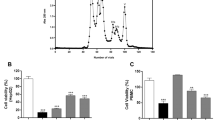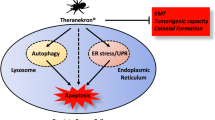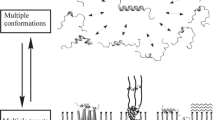Abstract
Prostate cancer is the second most common cancer in men and the second leading cause of cancer-related deaths among men in the western world. Finding a cure for prostate cancer is urgently needed. Scorpion venoms are rich sources of biologically active peptides, among which the non-disulfide bridged peptides constitute an important group displaying multifunctional activities. The non-disulfide bridged scorpion venom peptides are rarely identified and poorly characterized so far. In this work, we report the molecular cloning and functional characterization of a novel non-disulfide bridged peptide from the venomous gland cDNA library of the Moroccan scorpion Androctonus mauritanicus. Named Mauriporin, the peptide was found to be composed of 48 residues and circular dichroism analysis revealed the peptide to display a well defined α-helical structure in membrane mimicking environments. A synthetic replicate of Mauriporin was found to exert potent selective cytotoxic and antiproliferative activity against prostate cancer cell lines (IC50 4.4–7.8 μM) when compared with non-tumorigenic cells. In this concentration range, Mauriporin produced also negligible degrees of hemolytic activities against mammalian erythrocytes. Apoptotic studies displayed that Mauriporin is not causing cell death through an apoptotic-mediated pathway but possibly through a necrotic mode of cell death. In conclusion Mauriporin may offer a novel therapeutic strategy in the treatment of prostate cancer considering its significant cytotoxic potency against prostate cancer cells and low toxicity to non-tumorigenic cells.








Similar content being viewed by others
References
Almaaytah A, Zhou M, Wang L, Chen T, Walker B, Shaw C (2012) Antimicrobial/cytolytic peptides from the venom of the North African scorpion, Androctonus amoreuxi: biochemical and functional characterization of natural peptides and a single site-substituted analog. Peptides 35:291–299
Antonarakis ES, Eisenberger MA (2011) Expanding treatment options for metastatic prostate cancer. N Engl J Med 364:2055–2058
Chen T, Folan R, Kwok H, O’Kane EJ, Bjourson AJ, Shaw C (2003) Isolation of scorpion (Androctonus amoreuxi) putative alpha neurotoxins and parallel cloning of their respective cDNAs from a single sample of venom. Regul Pept 115:115–121
Chen T, Walker B, Zhou M, Shaw C (2005) Molecular cloning of a novel putative potassium channel-blocking neurotoxin from the venom of the North African scorpion, Androctonus amoreuxi. Peptides 26:731–736
Corbier C, Krier F, Mulliert G, Vitoux B, Revol-Junelles AM (2001) Biological activities and structural properties of the atypical bacteriocins mesenterocin 52b and leucocin b-ta33a. Appl Environ Microbiol 67:1418–1422
Corona M, Bolivar F, Becerril B (2000) Peptides and genes coding for scorpion toxins that affect ion-channels. Biochimie 82:861–868
Coughlin SS (2008) Surviving cancer or other serious illness: a review of individual and community. Resources 58:60–64
Deshane J, Garner CC, Sontheimer H (2003) Chlorotoxin inhibits glioma cell invasion via matrix metalloproteinase-2. J Biol Chem 278:4135–4144
Dobrzynska I, Szachowicz-Petelska B, Sulkowski S, Figaszewski Z (2005) Changes in electric charge and phospholipids composition in human colorectal cancer cells. Mol Cell Biochem 276:113–119
D’Suze G, Schwartz EF, García-Gómez BI, Sevcik C, Possani LD (2009) Molecular cloning and nucleotide sequence analysis of genes from a cDNA library of the scorpion Tityus discrepans. Biochimie 91:1010–1019
Fletcher JI, Haber M, Henderson MJ, Norris MD (2010) ABC transporters in cancer: more than just drug efflux pumps. Nat Rev Cancer 10:147–156
Goudet C, Chi CW, Tytgat J (2002) An overview of toxins and genes from the venom of the Asian scorpion Buthus martensi Karsch. Toxicon 40:1239–1258
Gupta SD, Gomes A, Debnath A, Saha A, Gomes A (2010) Apoptosis induction in human leukemic cells by a novel protein Bengalin, isolated from Indian black scorpion venom: through mitochondrial pathway and inhibition of heat shock proteins. Chem Biol Interact 183:293–303
Hoskin DW, Ramamoorthy A (2008) Studies on anticancer activities of antimicrobial peptides. Biochim Biophys Acta 1778:357–375
Huang YB, He LY, Jiang HY, Chen YX (2012) Role of helicity on the anticancer mechanism of action of cationic-helical peptides. Int J Mol Sci 13:6849–6862
Ilić N, Novković M, Guida F, Xhindoli D, Benincasa M, Tossi A, Juretić D (2013) Selective antimicrobial activity and mode of action of adepantins, glycine-rich peptide antibiotics based on anuran antimicrobial peptide sequences. Biochim Biophys Acta 1828:1004–1012
Jemal A, Bray F, Center MM, Ferlay J, Ward E, Forman D (2011) Global cancer statistics. CA Cancer J Clin 61:69–90
Klotz L, Zhang L, Lam A, Nam R, Mamedov A, Loblaw A (2010) Clinical results of long-term follow-up of a large, active surveillance cohort with localized prostate cancer. J Clin Oncol 28:126–131
Kozminsky-Atias A, Bar-Shalom A, Mishmar D, Zilberberg N (2008) Assembling an arsenal, the scorpion way. BMC Evol Biol 8:333
Lehmann J, Retz M, Sidhu SS, Suttmann H, Sell M, Paulsen F, Harder J, Unteregger G, Stöckle M (2006) Antitumor activity of the antimicrobial peptide magainin II against bladder cancer cell lines. Eur Urol 50:141–147
Leibowitz RL, Tucker SJ (2001) Treatment of localized prostate cancer with intermittent triple androgen blockade: preliminary results in 110 consecutive patients. Oncologist 6:177–182
Leuschner C, Hansel W (2004) Membrane disrupting lytic peptides for cancer treatments. Curr Pharm Des 10:2299–2310
Mason AJ, Marquette A, Bechinger B (2007) Zwitterionic phospholipids and sterols modulate antimicrobial peptide-induced membrane destabilization. Biophys J 93:4289–4299
Matsuzaki K, Sugishita K, Fujii N, Miyajima K (1995) Molecular basis for membrane selectivity of an antimicrobial peptide, magainin 2. Biochemistry 34:3423–3429
Moerman L, Bosteels S, Noppe W, Willems J, Clynen E, Schoofs L, Thevissen K, Tytgat J, Van Eldere J, Van Der Walt J, Verdonck F (2002) Antibacterial and antifungal properties of alpha-helical, cationic peptides in the venom of scorpions from southern Africa. Eur J Biochem 269:4799–4810
Rodriguez de la Vega RC, Possani LD (2005) Overview of scorpion toxins specific for Na+ channels and related peptides: biodiversity, structure-function relationships and evolution. Toxicon 46:831–844
Ruiming Z, Yibao M, Yawen H, Zhiyong D, Yingliang W, Zhijian C, Wenxin L (2010) Comparative venom gland transcriptome analysis of the scorpion Lychas mucronatus reveals intraspecific toxic gene diversity and new venomous components. BMC Genomics 11:452
Saraste A, Pulkki K (2000) Morphologic and biochemical hallmarks of apoptosis. Cardiovasc Res 45:528–537
Schwartz EF, Diego-Garcia E, Rodriguez de la Vega RC, Possani LD (2007) Transcriptome analysis of the venom gland of the Mexican scorpion Hadrurus gertschi (Arachnida: Scorpiones). BMC Genomics 8:119
Schweizer F (2009) Cationic amphiphilic peptides with cancer-selective toxicity. Eur J Pharmacol 625:190–194
Siegel R, Naishadham D, Jemal A (2012) Cancer statistics 2012(62):10–29
Wang K, Zhang B, Zhang W, Yan J, Li J, Wang R (2008) Antitumor effects, cell selectivity and structure–activity relationship of a novel antimicrobial peptide polybia-MPI. Peptides 29:963–968
Wang C, Li H, Li S, Tian L, Shang D (2012) Antitumor effects and cell selectivity of temporin-1CEa, an antimicrobial peptide from the skin secretions of the Chinese brown frog (Rana chensinensis). Biochimie 94:434–441
Wilt TJ, MacDonald R, Rutks I, Shamliyan TA, Taylor BC, Kane RL (2008) Systematic review: comparative effectiveness and harms of treatments for clinically localized prostate cancer. Ann Intern Med 148:435–448
Yoon WH, Park HD, Lim K, Hwang BD (1996) Effect of O-glycosylated mucin on invasion and metastasis of HM7 human colon cancer cells. Biochem Biophys Res Commun 222:694–699
Zelefsky MJ, Kuban DA, Levy LB, Potters L, Beyer DC, Blasko JC, Moran BJ, Ciezki JP, Zietman AL, Pisansky TM, Elshaikh M, Horwitz EM (2007) Multi-institutional analysis of long-term outcome for stages T1–T2 prostate cancer treated with permanent seed implantation. Int J Radiat Oncol Biol Phys 67:327–333
Zeng XC, Li WX, Peng F, Zhu ZH (2000) Cloning and characterization of a novel cDNA sequence encoding the precursor of a novel venom peptide (BmKbpp) related to a bradykinin-potentiating peptide from Chinese scorpion Buthus martensii Karsch. IUBMB Life 49:207–210
Zeng X, Corzo G, Hahin R (2005) Scorpion venom peptides without disulfide bridges. IUBMB Life 57:13–21
Zeng X, Wang S, Nie Y, Zhang L, Luo X (2012) Characterization of BmKbpp, a multifunctional peptide from the Chinese scorpion Mesobuthus martensii Karsch: gaining insight into a new mechanism for the functional diversification of scorpion venom peptides. Peptides 33:44–51
Author information
Authors and Affiliations
Corresponding author
Electronic supplementary material
Below is the link to the electronic supplementary material.
Rights and permissions
About this article
Cite this article
Almaaytah, A., Tarazi, S., Mhaidat, N. et al. Mauriporin, a Novel Cationic α-Helical Peptide with Selective Cytotoxic Activity Against Prostate Cancer Cell Lines from the Venom of the Scorpion Androctonus mauritanicus . Int J Pept Res Ther 19, 281–293 (2013). https://doi.org/10.1007/s10989-013-9350-3
Accepted:
Published:
Issue Date:
DOI: https://doi.org/10.1007/s10989-013-9350-3




